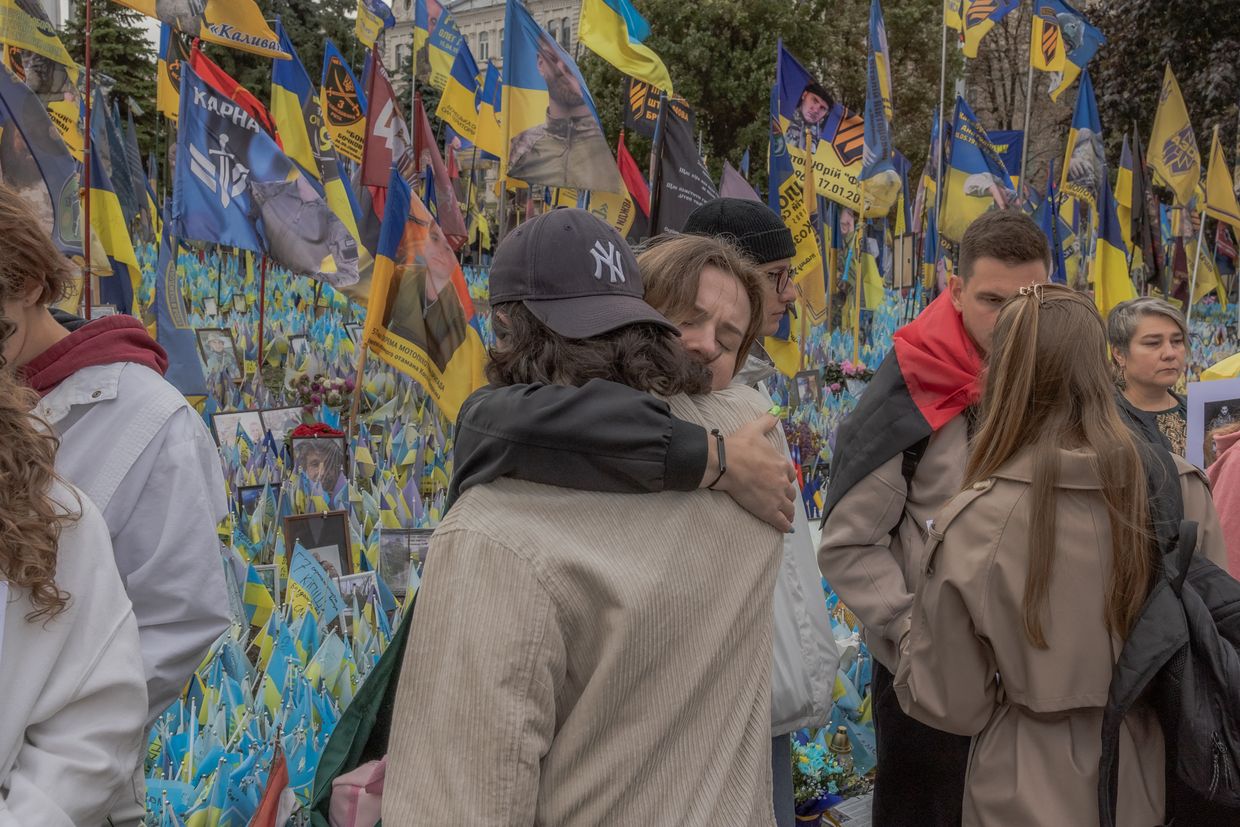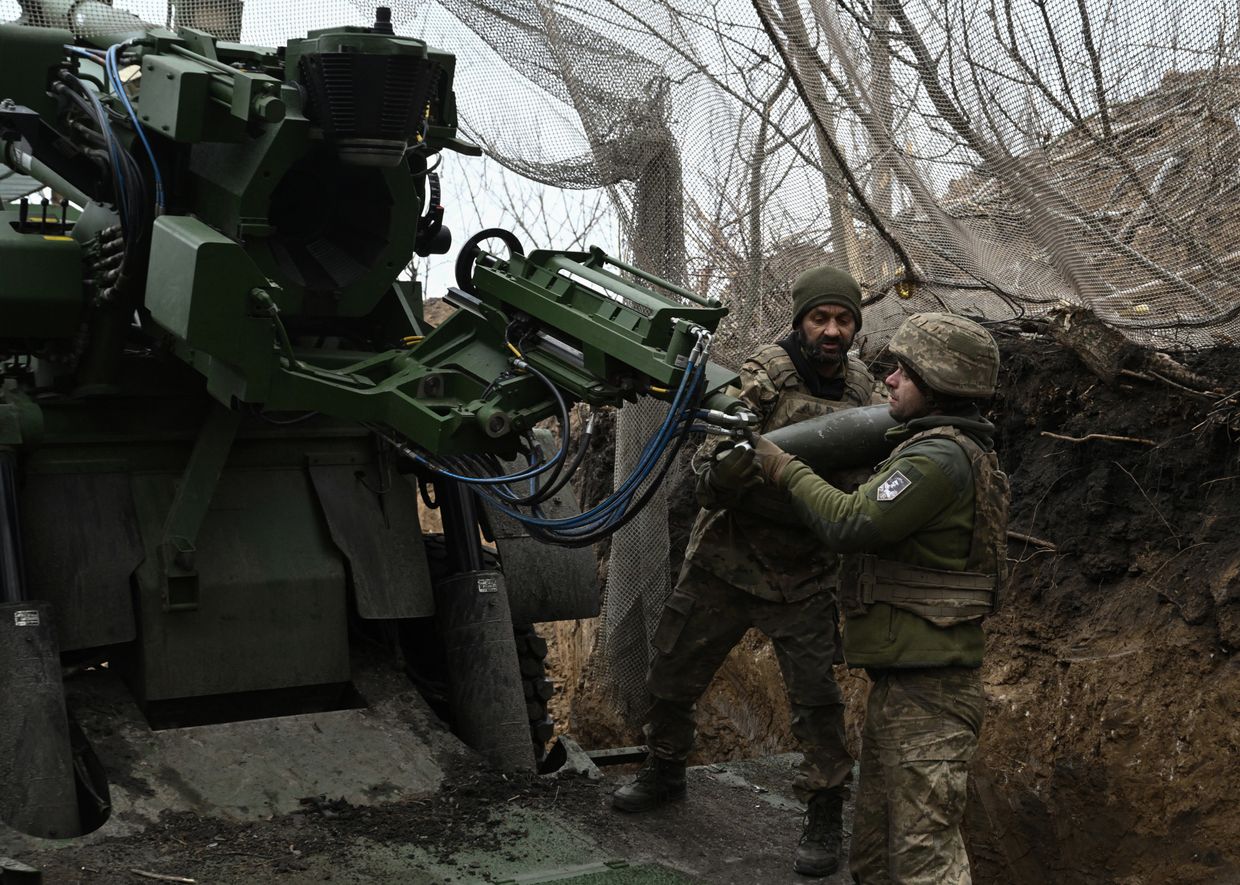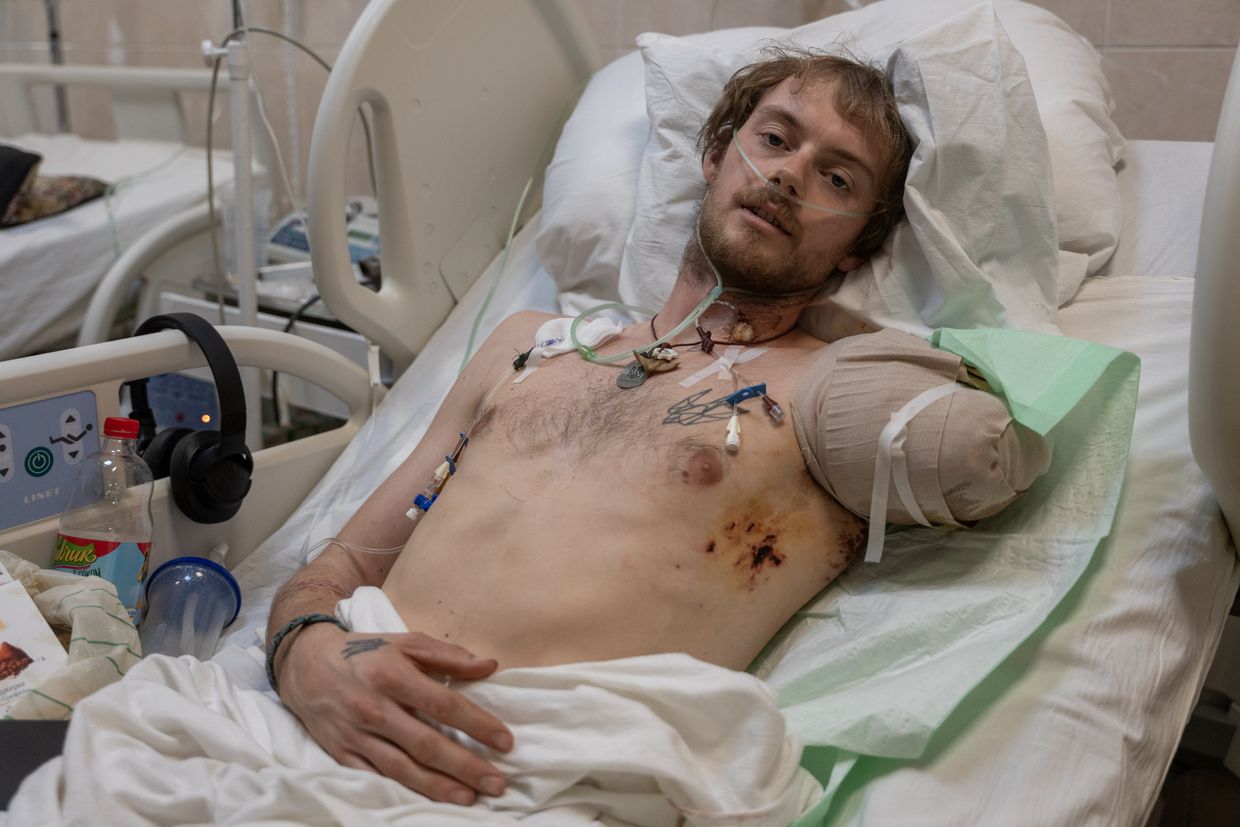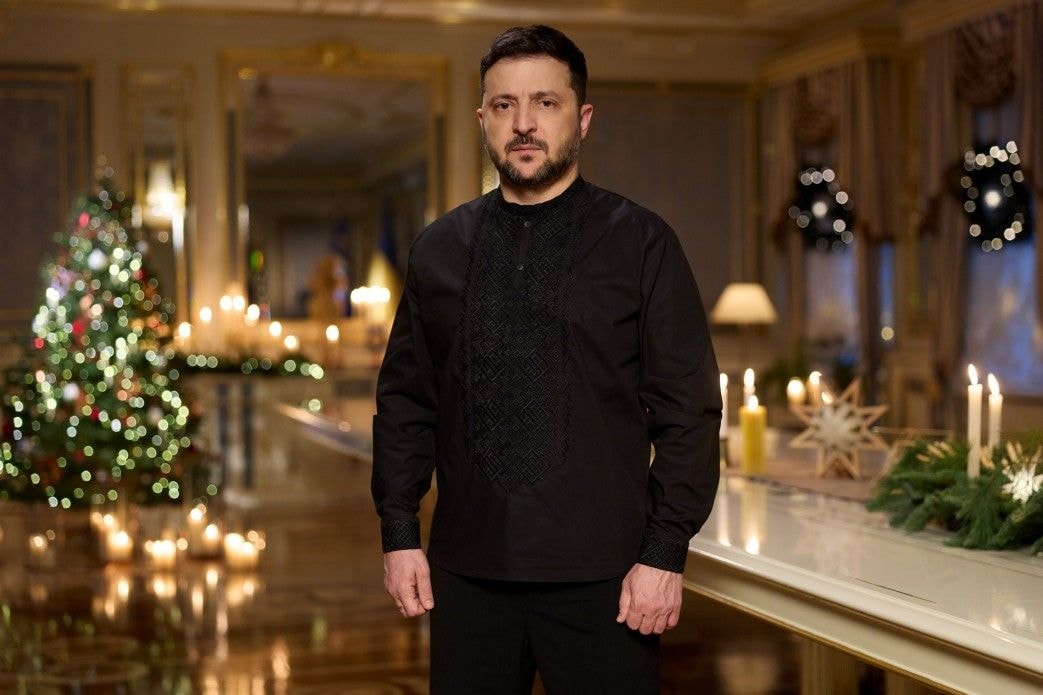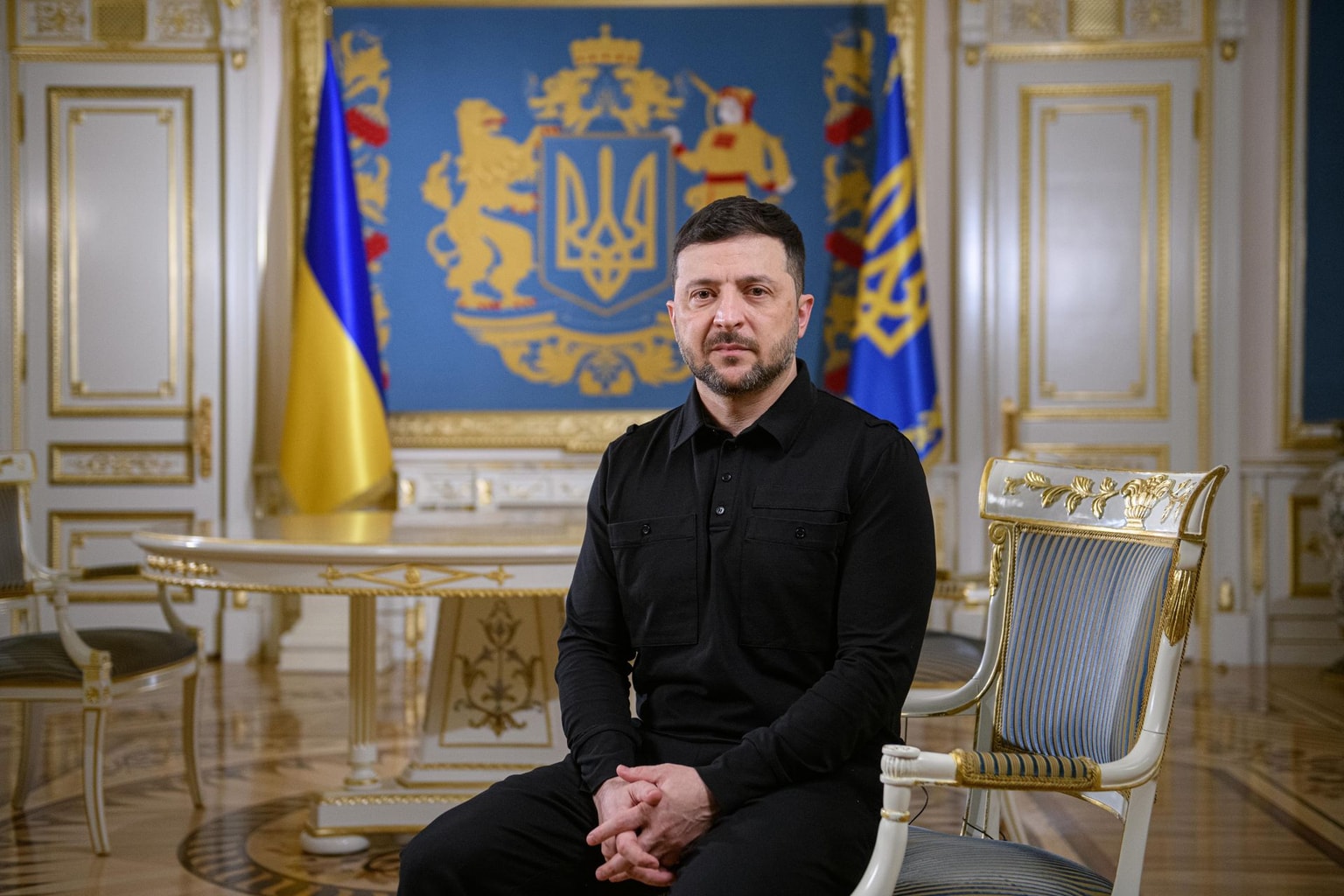
As Trump and Moscow align their vision, battle to stabilize Donetsk front rests on a knife edge
Amid the escalating geopolitical circus, Ukrainian soldiers fighting in between order and chaos assert that the only way to stop Russia remains on the battlefield.
Two Ukrainian mortarmen at a firing position near Pokrovsk, Donetsk Oblast, on Feb. 3, 2025. (Francis Farrell/The Kyiv Independent)
Editor’s note: In accordance with the security protocols of the Ukrainian military, soldiers featured in this story are identified by first names and callsigns only.
DONETSK OBLAST – Scanning an array of nine video feeds from a command point in an abandoned summer, mortar battery commander Tymur “Babai” searches for movement.
On this work video call that continues 24/7, each user is a colleague, but the cameras don’t look into living rooms.
Instead, each screen shows the eyes of a different Ukrainian drone, scanning the battlefield for Russian targets.
On a couple of screens, the unmistakable slanted tower and huge pulley of a Ukrainian coal mine can be seen.
Yesterday, drone pilots of his unit, the 23rd Special Purpose Battalion of Ukraine’s Presidential Brigade, were hunting Russian infantrymen in the mine buildings; videos on Babai’s phone show the last moments of the enemy soldiers’ lives, caught unaware as the drones flew right through the windows.
“It’s just meat, meat, meat;” says Babai of his enemy’s tactics, “they mobilize someone, and within a week, they’re already sitting in a trench. They have this human conveyor belt, and they’ll keep sending more and more.”
“Here, the soldiers are unprepared — there’s no elite assault force or anything like that, just cannon fodder. They give them a rifle, tell them, ‘Go there, those are your comrades, and shoot at anything that moves.’”

Rising by the railway just outside the village of Kotlyne, this small mine, one of dozens dotting the landscape of Donetsk Oblast, represents the very frontier of Russia’s westward advance to outflank the embattled city of Pokrovsk.
Failing to make progress with a direct assault on Pokrovsk since approaching the southern outskirts of the city in September, Russian forces have turned to a time-honored tactic of trying to surround defenders with wide pushes to Pokrovsk’s west and east.
Day by day, the offensive also brings with it a grim new reality: that Russia’s war could soon enter a new Ukrainian region.
According to open-source mapping, Russian forces are now less than five kilometers from the border of Dnipropetrovsk Oblast, which has not so far seen fighting on the ground.

Though Pokrovsk is still far from being surrounded, further south, the situation is markedly more dire.
In the aftermath of the fall of Kurakhove in January, elite Ukrainian brigades, though badly depleted, continued to cling on to a pocket of territory just west of the city, despite being encircled on three sides.
In mid-February, the Kurakhove pocket began to collapse, and now, the question looms of whether a more evened-out front line will be what Ukraine needs to truly knock the wind out of Russia’s offensive, if only temporarily.
On the geopolitical front, the last frosty weeks of winter have brought with them chilling signs for Ukraine.
But as the world’s focus fixates on U.S. President Donald Trump and his alignment with Moscow’s war narrative, a desperate struggle to stabilize the Donetsk Oblast front line is continuing uninterrupted.
The Kyiv Independent spent two weeks in the Pokrovsk and Kurakhove sectors of the front line, speaking to infantry and artillery commanders, medics, and drone pilots.
Though all spoke of heavy fighting and frequent Russian assaults, attacks were reported to have seen a relative lull in the final weeks of winter.
“When you look at the whole situation, you could say it's a small operational pause that we've observed,” Emil Kastehelmi, a Finnish military analyst and member of the Black Bird Group open-source intelligence collective, told the Kyiv Independent
“They have kept the contact, advancing small steps here and there, but the larger-scale offensive operations have died down.”
On the edge of chaos
In a narrow treeline between fields of frost, three Ukrainian mortarmen get to work by the dim red light of head torches.
Dropping 82mm shells into a weapon that hasn’t changed much for over a century, they go about their work without seeing the result, laying fire down on the coordinates given by Babai’s officers at the command point.
The crew fires around half a dozen shells throughout the night, laying down fire on Russian infantry positions in the hope of crippling the next planned enemy assault.
These mortar positions are less than two kilometers (1.2 miles) from the Russian forces digging in around Kotlyne and the coal mine.
A week earlier, said mortarman Artem “Rio,” things were a lot hotter here.
“When we came in, it was a chaotic situation, it seems to have evened out,” he said.
“We held on to our positions well, but the flanks were pushed back, and we were basically surrounded for a while there.”
According to commander Babai, the hectic month his unit has spent fighting here outside Pokrovsk bears all the hallmark signs of systemic organization problems in the Ukrainian military.
“When we were brought here our battalion was already not combat-effective. We had less than 30 infantrymen left,” he said.
“When we came in here, into the chaos we found ourselves in, where there was no established position, no properly constructed supply routes, we ended up in a head-on battle. Some of us were killed while disembarking near trenches that were supposed to be ours, but in reality, they were occupied by the enemy.”

Problems in communication in command are only exacerbated by the manpower crisis, asserted Babai, who has routinely had to take the painful step of transferring his own artillerymen into the infantry.
“When the high command looks at the roster and sees 400 troops in the battalion, they think it’s a combat-effective unit,” he said. “They don’t actually check how many soldiers are assigned to each company or realize that there is no infantry, and send us in anyway.”
“Our infantry ran out pretty quickly, while our flanks folded, and we had to retreat to Kotlyne.”
The general chaos recalled by Babai testifies to the critical situations that arise when positions are lost in quick succession, leaving the flanks of neighboring units exposed without their knowledge, and leaving mortarmen like Rio’s crew in danger of being trapped in a direct firefight.
Worst of all is the lot of the infantry in such conditions, forced to fight off assaults from makeshift positions, with little prospect for planned rotation.
“A soldier deploys and might sit there for a week, two weeks, a month — until he gets wounded or until someone else returns from the hospital to replace him,” said Babai.
“Under these conditions, with constant assaults, guys hold out for a week or two, and then we see desertion cases. These are guys who fought hard, repelled dozens of attacks — but the assaults don’t stop, and their minds can’t hold up forever. Their psyche breaks.”

With the arrival of freezing temperatures in mid-February, Russian offensives in the Kotlyne sector have died down, even allowing for successful local counterattacks.
On the southern outskirts of Pokrovsk, Ukrainian troops took back the village of Pishchane, while in Babai’s sector, Ukrainian assault battalions and special forces took back the coal mine.
“In the Pokrovsk sector, the initiative is beginning to shift to us,” said a Ukrainian Special Forces sniper fighting in the area, who declined to be identified for security reasons.
“They are taking crazy losses; I’ve never seen anything like it.”
If Ukraine can keep up the pressure and uses its time to reorganize its defense, Russian attacks in the area could be stopped dead in their tracks for a long time, according to Babai.
“The enemy loses morale and can no longer assault,” he said.
“They scatter, hiding not even in trenches but in basements, and they don’t move anywhere. Their commanders don’t know where their personnel are, while we simply finish off the remnants.”
Holding firm
In a grove of trees somewhere southwest of Pokrovsk, company commander Oleksandr “Willy” arrives with his team at dusk in an armored vehicle to begin his shift.
“I hope the day will be quiet, but maybe we could see some movement from their infantry,” he says as he takes his place in front of the computer screen.
“They could try to crawl up to our positions in their small groups.”
This group is an infantry company of Ukraine’s 14th National Guard Brigade, better known as Chervona Kalyna (Red Viburnum) after the subject of a famous Ukrainian folk song.
Formed in 2023 as part of the Assault Guard group of new brigades fighting under the Interior Ministry, Chervona Kalyna first saw action in the 2023 Zaporizhzhia Oblast counteroffensive before being transferred to the defense of Pokrovsk in the latter half of 2024.
This small dugout, divided crudely into a workspace and a flat area for sleeping, is the brain of the day-to-day positional infantry warfare that has defined this war.

Next to the ubiquitous drone feeds, a neat Excel spreadsheet displays the names of the company’s men currently out on positions.
Each column of callsigns in the table represents a small, isolated group of Ukraine’s most precious resource at this stage of the full-scale war: trained, motivated infantrymen.
Even when manning organized lines of defense, Ukrainian infantry have found themselves in isolated conditions that only get more brutal with each month, as the skies get increasingly saturated with Russian drones.
Every hour throughout the night, Willy and his team check in on each position, one by one.
The calm, laconic replies across the radio “450 (Ukrainian military code for everything under control), online,” provide a testament that the night is unusually quiet.
A rarity in the Pokrovsk area, the Chervona Kalyna brigade has been able to hold the same positions for many months, thanks both to favorable terrain in their sector and a well-organized, well-manned defense.
According to Willy though, this hasn’t stopped Russian forces from attempting to break their line with near-daily assaults.
“We try to deal with them before they make it to the position, especially with drones,” he said, "the problem is that sometimes they manage to take shelter in the basements and dig in.”
“They are looking for weak points, and when they find them, that's when they bring in more vehicles, from motorcycles to tanks.”

Sure enough, as dawn breaks, Russian forces are spotted on the move on the outskirts of the occupied town of Hrodivka.
Two old motorcycles carrying two enemy infantrymen each can be seen speeding along the last street towards the Ukrainian lines.
Before reaching their destination, the soldiers can be seen hastily abandoning their steeds in the middle of the road; sure enough, a few seconds later, the bikes are struck with two small explosions, one after the other.
“That’s our FPVs (first-person view drones) working,” says Willy, watching the screen closely.
Abandoning whatever their original mission was, the four Russian soldiers take shelter in a wrecked basement.
Now, throughout the day their location will be known to Ukrainian fire and drone teams, who have the rest of the day to smoke them out.
Escape from hell
Further south, in an unassuming hut on the edge of a village, the true cost of the fierce battles in the Kurakhove sector is on full display.
At a stabilization point run by Ukraine’s 37th Marine Brigade, casualties evacuated from the fighting right in the epicenter of the Kurakhove pocket are given emergency treatment before further transportation to larger military hospitals.
Just before the Kyiv Independent arrived for the medics’ night shift, a large group of wounded and dead had passed through, victims of a Russian Lancet drone strike on their vehicle.
The shift continues, first with a drone team who made it out of a Russian attack on their basement with no more than concussions, then a lone, newly-mobilized infantryman who took light shrapnel damage to the arm on his very first combat mission.
Along with the 37th Marines, the Kurakhove pocket is being defended by some of Ukraine’s top brigades, including the 46th Airmobile and 79th Air Assault Brigades, who have fought in the area since the battle of Marinka, over 30 kilometers to the east.
Despite their heroic effort, the Ukrainian high command’s decision to hold onto semi-encircled areas like this one has come under criticism for causing unnecessary personnel loss and exacerbating the already dire manpower crisis.
“In some places, it might be worth it to stay and defend, if there are especially favorable locations,” said Kastehelmi, “but in many places, it seems that the Ukrainians are just holding ground for the sake of holding ground.”
“Getting into pockets stretches the front line, and creates excess amounts of front line in a situation where the units are already depleted of manpower.”
“At the moment, all the wounded are all either very serious or very mild,” said senior medic Illia “Ptakh,” speaking in between treating the wounded.
“Either they have been hit and can't be evacuated for days, making light wounds become serious, or they managed to get out as soon as they were hit.”
With the activity of enemy drones only increasing over 2024, the evacuation of soldiers several days after being wounded — what used to be a nightmare scenario in military medicine — is now a grim new normality.
As the red winter sun rises over the steppe, a wounded infantryman is delivered to the stabilization point.
“Shrapnel wounds on the right side of the face, including the eye” — the paramedic’s call lets the medics know who and what they can expect to come through the doors.
Kostiantyn “Hostryi,” the wounded soldier, stumbles in, the medics helping him gingerly remove his clothes.
“It's very tense,” he says, with an impressively calm tone as the medics tend his wounds with disinfectant swabs.
“I was the last one standing, I hung on there for four days on my own (after being wounded). There were assaults. My group was all killed, and they couldn't get us out. They just dismantled our dugouts with FPVs.”

Within half an hour, Hostryi’s company commander arrives, asking him about the hellish situation that his soldier escaped from.
“When you were retreating, were you shouting out to the guys that were hit?” the commander asked.
“As I ran to the other basement, I couldn’t stay outside long, they were dropping bombs on us from drones,” Hostryi replied. “But yes, I shouted, and nobody called back.”
“Good job, now get healed up,” the commander replies after a pause, tapping Hostryi’s arm before heading out.
For Ptakh, Hostryi’s laconic tone after such a dramatic ordeal is no surprise; all in all, while everyone is tired, morale in his unit remains resolute.
“Of course, those who have lost limbs have lost a part of themselves, it's pretty hard to come back from that,” he said, “but the others, who just took a little shrapnel, are the most motivated people I have seen, they get patched up and off they go to fight again.
“People have motivation, their country is being taken from them. It's not a question of fighting morale, it's motivation to continue living at all.”
Digging deep
The arrival of spring will likely bring with it new challenges to the defense of Donetsk Oblast, as the fresh leaves offer better cover from sight for enemy infantry assault groups, and the clearer skies open the field for the widespread use of Russia’s feared heavy glide bombs.
Going forward, the result of these battles will ultimately hinge greatly on Moscow’s ability to keep feeding men into Russian infantry assault teams, said Kastehelmi.
“With the tactics the Russians use, it's really difficult to actually attrit them to the point where their offensive would culminate at all,” he said.

Over a year after attention was first brought to the need to build strong fortifications to wage the most effective defensive war possible, the failures to build extensive, well-designed lines of defense in advance have been well-documented.
Shortcomings in fortification-building — a task usually split between military engineers and civilian contractors — have been particularly stark in Donetsk Oblast, where Russia’s rapid advance and the proliferation of drones mean that excavators are frequently targeted, while chaotic retreats impede Ukraine’s ability to prepare coherent lines of defense as positions get quickly overrun.
In the case of the Kurakhove area, a formidable line of Ukrainian fortifications along the Vovcha River was rendered effectively useless, facing south rather than east, from where Russia attacked.
More naturally favorable terrain in Dnipropetrovsk Oblast, which has been well-fortified in advance, offers some hope that Russian advances could be stopped in their tracks if they enter the region, according to Kastehelmi.
“There are some better places to defend, and there are new lines to retreat to,” he said, but the problem is that if you don't have enough people to hold the worst positions, then the defensive line is basically only as strong as its weakest spot.”
With Trump’s willingness to get tough on Russia in serious doubt, Moscow must be ground down here on the battlefield, by the hands of Ukrainians, according to Babai.
“What we need is to establish a solid defensive line and then move in the infantry,” he said. “We have the mortars, UAVs, and strike drones — we just need to set up a strong defense.”
“Relying on Western partners is pointless.”

Here and now, the role of the Ukrainian soldiers fighting here in shifting the global balance of power against Moscow is pivotal, but not something many of them focus on.
“I don't watch the news anymore, it's just hard,” said Willy in the dugout, “my duty is to care for my people, not listen to politicians.”
“Before, when you read about the possibility of negotiations, you might think: 'Maybe soon I'll be on the beach with my fiance, maybe I can start thinking about raising a child.' But now it's the third year of the war, I'm not interested in this theater.”
Natalia Yermak contributed to reporting.
Note from the author:
Hi, this is Francis Farrell, the author of this piece. Well, here we are, on the edge of what looks like a global geopolitical abyss. But, as I hope this piece can remind readers, the real fight is happening in the frozen fields of Donbas, where success or failure to stop Russia's advances could end up being more pivotal than any big words or mineral deals. Whatever ends up happening, you can count on the fact that we will take you right there. Please consider supporting our reporting.

